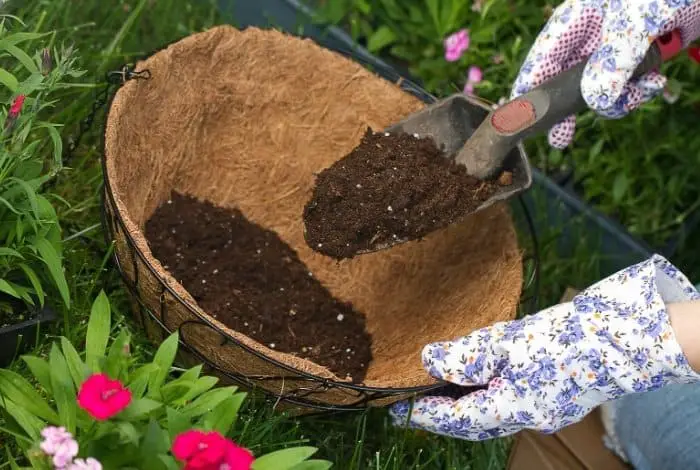Last Updated on April 19, 2022
Those who enjoy gardening and growing indoor plants need to learn how to sterilize potting soil to destroy all the bugs and pathogens.
Sterilized and clean soil will do a lot of good for your plants. Using the same potting soil repeatedly can lead to a buildup of fungal spores, weed seeds, harmful pathogens, and garden pests. If you opt to reuse the same soil instead of replenishing it, it would be best to sterilize it often. This leaves you with clean uncontaminated growing soil for your plants.
Why Should You Sterilize Potting Soil?
Sterilizing potting soil is very important! Soil contains harmful bacteria, pathogens, and fungi that harms or kills the plants. Insects and larvae may also be present causing harm to plants. Store-bought soil that claims to be sterilized cannot be trusted. It may be contaminated through bag punctures, mishandling, shelf life, or other elements.

How to Sterilize Potting Soil
Sterilizing your potting soil is easy and beneficial to plants. You only need a few household items and about 45 minutes to complete the process.
Materials Required
- Large roasting pan or a baking sheet
- Oven
- Aluminum foil
- Meat thermometer
- Mixing spoon
- Fertile soil
- Water
Black Gold 1311002 8-Quart Seedling Mix
Read more about Gypsum Soil Amendment
Steps to Follow when Sterilizing Potting Soil
- Prepare your soil for sterilization. The soil must be moist enough to be able to compact into a ball. But it should crumble when pressure is removed. This is done by packing a ball of soil between your hands and adding a little water. Mix until you get the right consistency.
- Place the soil into the roasting pan or baking sheet. Evenly distribute it in the pan and break any soil lumps available. Keep the soil under 4 inches deep and do not fill the edges of the pan. Cover the pan or sheet tightly with a foil. The foil must be tight and secure to prevent moisture loss and the soil burns. Make a hole in the center of the foil large enough for the meat thermometer to fit in through it.
- Start the sterilization process. Set the oven at a low temperature and Place the tray inside. The temperature for sterilization should be 180 degrees Fahrenheit. Temperatures above this may cause burning. Burning the soil changes the chemical composition of the soil. The burnt soil will cause harm to plants. Allow the soil to burn for about 30 minutes at a steady temperature. You must pay close attention to temperature fluctuation to avoid using too high or too low heat.
- Cool your use before using it. After baking for 30 minutes, remove the soil from the oven and let it sit until it reaches room temperature. To allow heat to escape, carefully lift the corner of the foil. Be very careful as you do this as the escaping steam will be very hot and can cause burns.
- Use your soil. Once the soil has cooled down and removed from the pan, go ahead and place it in the pot. Remember to sterilize your growing pots too so that they do not infect the new soil. Plant your seeds no deeper than 4 times the diameter of the seed. Water the sterilized soil with a mister to avoid flooding it. Place the soil and the sown seeds into a cool room, avoid direct sunlight until germination.
Conclusion
Sterilizing potting soil indoors will bring a repulsive odor that is awful and smells earthy. Some people can tolerate it while others cannot and might be allergic to the odor. Before sterilizing your soil, open your windows and turn on a fan. The odor will not linger for long if the indoor air is circulating with the outdoor fresh air.
FAQs
What shouldn't use to sterilize soil?
I've tried bleach, I used a little bleach to clean up some moldy soil (which had been sitting in a bag for a long time) and then put it in my garden, and it seemed fine. I used one cup of bleach in three gallons of water. It smelled like rotten eggs for a couple days and I had to throw out all of my plants. I would never use bleach again.
I've tried soaking it in ammonia, but it didn't do much. But I don't think it's necessary or recommended.
What does work?
The easiest way to sterilize soil is to use a heat gun. This is actually a form of pasteurization, which is much faster than using steam or steam heat. The pasteurization process takes about 3 minutes to achieve a kill of all bacteria, while it would take days for a slow-acting sterilant like ethylene oxide to kill all of them. So, you can kill 99% of the bacteria in 3 minutes. It can be used to kill all kinds of bacteria and fungi. You can also use chemicals, which are usually toxic and will kill the organisms that you want to keep. The most common chemicals for this are chlorinated hydrocarbons. They have a low toxicity and are easy to use. A third option is to use physical methods such as digging up the soil and moving it to another location. Rubbing alcohol can be used as a disinfectant and also as a solvent to get rid of stubborn soil-based disease. Make sure you do not use it in any area with soil that has been previously treated with a fungicide, as it will react with the active ingredient and make the soil unusable. Hydrogen peroxide is another option. A better option would be to use an autoclave, which is a pressurized chamber that kills bacteria, viruses, fungi, and other pathogens.
Why sterilize soil?
Soil contains living organisms.
These organisms include bacteria, fungi, mites, nematodes, protozoa, and viruses. The presence of these organisms in soil is often considered undesirable. For instance, bacteria can cause disease or spoilage in food products.
What's the kind of mold that I should be worried about?
I'm not sure if you're aware, but there are two types of mold: "black" and "white". Black mold is toxic and may cause illness. White mold is not. You can easily tell the difference by looking at the mold, it will be white for "healthy" mold. If the mold is black, it's probably toxic and you should throw it away.

Lory is an avid gardener who loves spending time outdoors. She is passionate about using her green thumb to create beautiful, lush gardens for her friends and family. She finds joy in tending to her garden, trimming plants, and cultivating new species. She loves to share her knowledge and experience with others who have a similar enthusiasm for gardening. Lory is a true nature enthusiast who loves to share her enthusiasm for the outdoors with all who meet her.

